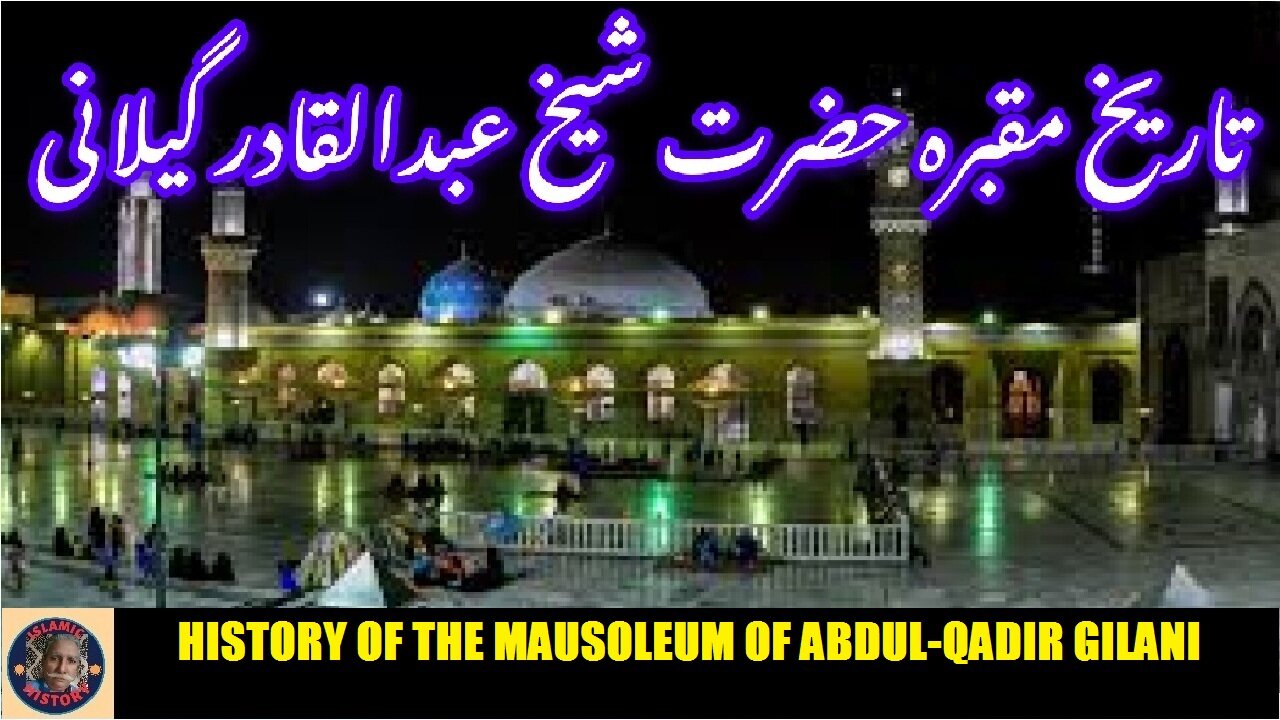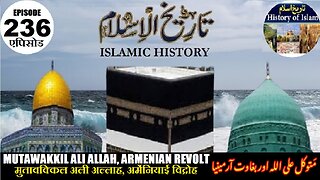Premium Only Content

History of the Mausoleum of Abdul-Qadir Gilani | عبدالقادر گیلانی کے مزار کی تاریخ
@islamichistory813 #IslamicHistory #CulturalLandmarks #Sufism
History of the Mausoleum of Abdul-Qadir Gilani
Dekhti Aankhooon aur sountay kaanoon ko Asslamoalaikum, sisters, brothers friends and elders, In this islamic holiest places informative videos, we present the fascinating history of the Mausoleum of Abdul-Qadir Gilani, an iconic site that honors one of the most influential figures in Sufism. Viewers we are describing the life of Abdul-Qadir Gilani, the construction of his mausoleum, and its enduring significance in the spiritual landscape of Iraq. we are describing the stories and traditions that surround this remarkable monument.
The Mausoleum of Abdul-Qadir Gilani, also known as Al-?a?rat Al-Qadiriyyah or Mazar Ghous, is an Islamic religious complex dedicated to Abdul Qadir Gilani, the founder of the Qadiriyya Sufi order, located in Baghdad, Iraq. Its surrounding square is named Kilani Square. The complex consists of the mosque, mausoleum, and the library known as Qadiriyya Library, which houses rare old works related to Islamic Studies. The son of the entombed scholar, Abdul Razzaq Gilani, is also buried there.
The complex was built near the Bab Ash-Sheikh ,romanized: The Sheikh's Gate) in Al-Rusafah, on the east bank of the Tigris. Al-Rusafah also contains the mosque of the founder of the Hanbali school of thought, Imam Ahmad ibn Hanbal.
During the reign of the Safavid Shah Ismail I, Gilani's shrine was destroyed. However, in 1535, the Ottoman Sultan Suleiman the Magnificent had a dome built over the shrine, and it exists to this day.
On 28 May 2007, the shrine was targeted by a car bomb attack which killed around 24 and injured 68. The attack caused serious damage to the shrine and the mosque, and destroyed the outer wall, a dome and a minaret.
Gilani was born in 1077 or 1078. Despite his popularity, his background is uncertain. His father (or perhaps grandfather) had the Iranian name of Jangi Dust, which indicates that Gilani was of Persian stock. His nisba means "from Gilan", an Iranian region located on the southwestern coast of the Caspian Sea.
During his stay in the city of Baghdad, Gilani was called ajami (non-Arab), which according to Bruce Lawrence may be because he spoke Persian alongside Arabic. According to the al-Nujum al-?ahira by the 15th-century historian Ibn Taghribirdi (died 1470), Gilani was born in Jil in Iraq, but this account is questioned by French historian Jacqueline Chabbi. Modern historians (including Lawrence) consider Gilani to have been born in Gilan. The region was then politically semi-independent and divided between local chieftains from different clans.
Gilani is claimed to have been a descendant of Muhammad's grandson Hasan ibn Ali; this claim is generally considered genuine by the Muslim community, including the Qadiriyya. Lawrence finds this claim inconsistent with Gilani's apparent Persian background, and considers it to have been "traced by overzealous hagiographers."
Gilani spent his early life in Gilan, the province of his birth. In 1095, he went to Baghdad. There, he pursued the study of Hanbali law under Abu Saeed Mubarak Makhzoomi and ibn Aqil. He studied hadith with Abu Muhammad Ja'far al-Sarraj. His Sufi spiritual instructor was Abu'l-Khair Hammad ibn Muslim al-Dabbas. After completing his education, Gilani left Baghdad. He spent twenty-five years wandering in the deserts of Iraq.
Gilani belonged to the Shafi'i and Hanbali schools of law. He placed Shafi'i jurisprudence (fiqh) on an equal footing with the Hanbali school (madhhab), and used to give fatwa according to both of them simultaneously. This is why al-Nawawi praised him in his book entitled Bustan al-'Arifin (Garden of the Spiritual Masters), saying:
We have never known anyone more dignified than Baghdad's Sheikh Muhyi al-Din 'Abd al-Qadir al-Gilani, may Allah be pleased with him, the Sheikh of Shafi'is and Hanbalis in Baghdad.
In 1127, Gilani returned to Baghdad and began to preach to the public.He joined the teaching staff of the school belonging to his teacher, al-Mazkhzoomi, and was popular with students. In the morning he taught hadith and tafsir, and in the afternoon he discoursed on the science of the heart and the virtues of the Quran. He was said to have been a convincing preacher who converted numerous Jews and Christians and who integrated Sufi mysticism with Islamic Law.
so sisters brothers and friends, inshaAllah tomorow we will be described History of the Tomb of Shah Rukn-e-Alam. Allah Hafiz
========================================
-
 9:58
9:58
ISLAMIC HISTORY
19 hours agoIslamic History Episode 236 Mutawakkil Ali Allah, Armenian Revolt متوکل علی اللہ ، بغاوت آرمینیا
8 -
 21:15
21:15
Actual Justice Warrior
13 hours agoJimmy Kimmel DECLARES Victory
5.03K17 -
 49:42
49:42
Liz Wheeler
15 hours agoWHO is Behind ANTIFA? | Ep 176
31.2K12 -
 8:30
8:30
MattMorseTV
16 hours ago $7.61 earnedThis just ENDED Newsom's CAREER.
157K51 -
 17:11
17:11
Nikko Ortiz
13 hours agoIs Poverty Your Fault?
10.7K11 -
 41:10
41:10
The Connect: With Johnny Mitchell
4 days ago $9.89 earnedInside The Sinaloa Cartel's Fight For Survival: How Mexico's Oldest Cartel Is Making It's Last Stand
40.7K16 -
 1:44:47
1:44:47
Side Scrollers Podcast
1 day agoKimmel RETURNS + Twitch University + More! | Side Scrollers
60.2K8 -
 5:43
5:43
GritsGG
1 day agoBest Way To Get Specialist EVERY Game!
34.2K2 -
 LIVE
LIVE
Lofi Girl
2 years agoSynthwave Radio 🌌 - beats to chill/game to
252 watching -
 6:48
6:48
Buddy Brown
13 hours ago $13.32 earnedWatch What Happens When you Set up a "Charlie Tent" at HBCU! | Buddy Brown
167K68